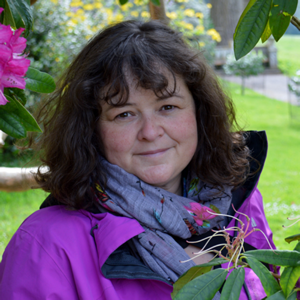Sexuality, Spirituality and the Body
According to Joan Borysenko, "the body is the way in,” when it comes to spirituality, sexuality and healing. “Life force energy," she says, "shows up as a spectrum of emotions. To work with life force energy you have to be in the moment. This seems to be the way to work with trauma and resilience. It’s less top down intellect, and more bottom up body-to-mind, how changes in the body show up in the mind, in our thought processes. Working with clients for years, I frequently see people who are traumatized have a moment of transcendence—they leave their body in trauma and enter a different reality, akin to a mystical experience. The spiritual realm is beyond religion. No matter what door you go through, if you talk to a mystic from any religion—Jew, Christian, Muslim—something larger than the individual mind occurs. They are all talking about the same thing: this immediate sense of recognition.”
The Therapist’s Subjectivity: A Look at Autism
The bedroom door is shut. I hear voices, recognize my parents’ and hear another unfamiliar voice. I stand in front of the keyhole, covering one eye with my hand; another eye is wide open close to the keyhole trying to catch what is happening behind the closed door. I feel the tension in the air. I don’t dare leave my room, so instead I’m hiding behind the door and checking what is happening through the keyhole.
Making Life Easy:
Drawing on fields from epigenetics to past-life regression to standard Western medicine, Dr. Christiane Northrup has distilled her knowledge into a comprehensive user’s guide to a healthy, happy, radiant life as she illuminates the mind, the soul and spirit.
Treating Trauma and Addiction with the Felt Sense Polyvagal Model: A Bottom-Up Approach
Just at a time when the wider world is waking up to a more compassionate and inclusive way of understanding trauma and addiction, a timely book that addresses these issues in personal, historical, embodied, and practical ways has arrived. In Treating Trauma and Addiction with the Felt Sense Polyvagal Model: A Bottom-Up Approach (Routledge, 2021), author and psychotherapist Jan Winhall both demystifies and depathologizes addiction.
Life Notes: Always Home for the Holidays
“When I was a child, Christmas happened on Christmas Eve. Mom, dad, sister, and I piled into the car and drove around the empty streets looking for Rudolf’s nose. I remember the silence illuminated by twinkling Christmas trees in windows and the slow, steady headlamps of whatever Chrysler dad was driving that year. But we were looking for the special light. The red one. Since we lived beneath the flightpath of the San Jose airport, it was not hard to find red blinking lights in the sky. Every year the question remained, “Which one is Rudolf’s nose?” It didn’t matter. My sister, Jenny, and I usually pointed one out and exclaimed, "There it is!" Mom and dad always answered with, “Let’s drive around a bit more, look at the neighborhood Christmas lights to give Santa time to bring your presents.” We did not complain because we knew that gifts were waiting under the tree when we returned home. It was like magic.
The Shattered Oak: An Author’s Reflection
My mother’s life was not easy. She dealt with and battled domestic violence, child abuse, suicide, and eventually mental illness. She was affected by and surrounded by the nature of mankind’s cruelty. And yet, she gave my siblings and I her gift of strength. In writing The Shattered Oak, I came to terms with her thought process and experienced her level of bravery and reliance. I finally comprehended her intense strength, courage, and determination by acknowledging her survivor skills and her deep love of faith that provided her comfort that she was never alone.
Letting in the Light
“I’m so exhausted!” Emily sighed as she slumped into the rocking chair. “The store is driving me crazy!”
Congenial and generally upbeat, Emily juggles complex roles as manager of a profitable men’s clothing franchise: engaging saleswoman, savvy boss and compassionate housemother for her “kids” as she calls her staff. Emily handles the pressures with genuine warmth and contagious wit. Despite changing business requirements and the kids’ idiosyncratic quirks, Emily remains surprisingly happy in her job, often affirming, “My job is fun. It makes me feel really good.”
Yet, on this vibrantly sunny summer day, something was different. The energy with which Emily entered the room was visibly and palpably low, as if a cloud had blocked the light that had been beaming through the window. With a wan twinkle at the edges of her usually lively eyes, Emily recounted the latest list of stressors involving inventory, customers and the kids.
Taking a Position on Integration
On a typically freezing February day in Southern Maine when icicles hang like gargoyles over the windows, frozen in place, destined never to move, even a short walk from the house to my office in the renovated barn, causes a damp chilliness to seep into my bones. My body, eager to ease from the stifling, stiffening cold into the felt sense of warmth from a thousand therapy sessions, was beginning to thaw when Carmen arrived. As it turned out, Carmen’s chill was destined to be a different story.
Contemporary Reichian Analysis
Increasing awareness and understanding of epigenetics and neuroplasticity in current research has resulted in a new perspective of psychotherapy that is integrated with neurobiological information. This information is at the root of an emerging paradigm shift in body psychotherapy that I call Evolutive Stage Neuromediator Vegetotherapy.
Somatic Relief for The Blues
Walking over to my chair, cell phone in hand, Bev exclaimed (the tone of her voice implying the answer was a given to her upcoming question), “Aren’t these pictures beautiful? Here, look at this one—I took it from the old Fort. Can you spot the house in the background across the inlet? That’s where my father would put the boat in the water to take us up the coast. Those were good times.” Bev’s photographs, composites of her beloved seas and shorelines along Maine’s southern and mid-coast, comprise a visual memorial to the beaches and bays that provided a measure of playfulness and serenity within the more chronic and painful vagaries of her childhood and adolescence.














